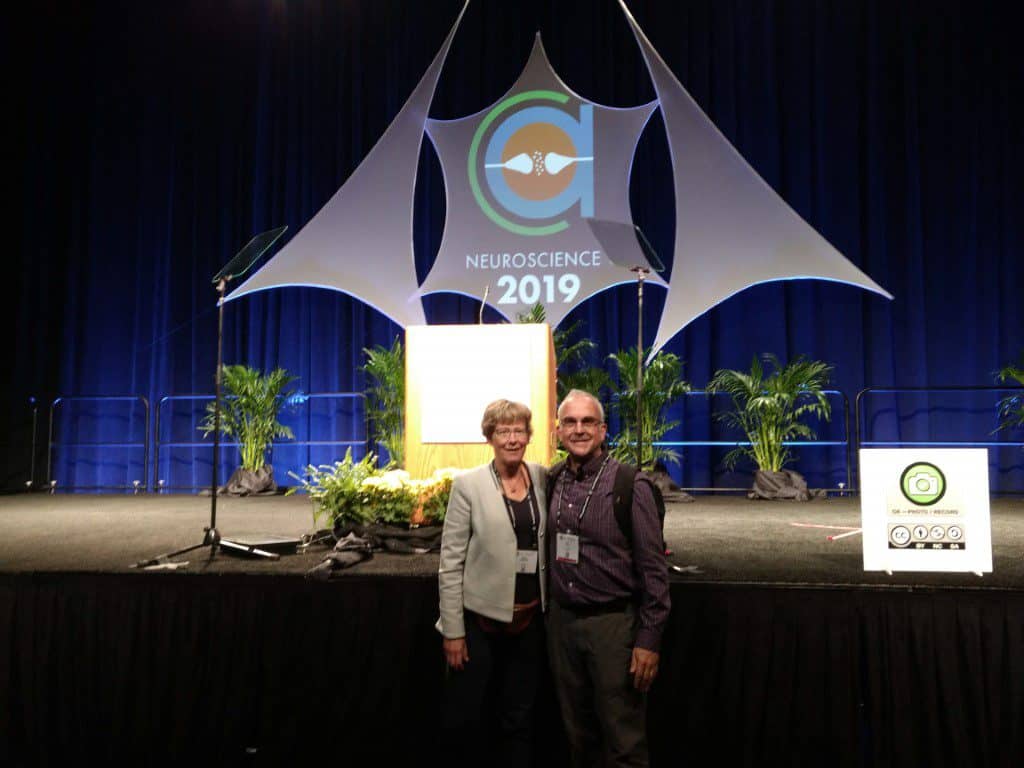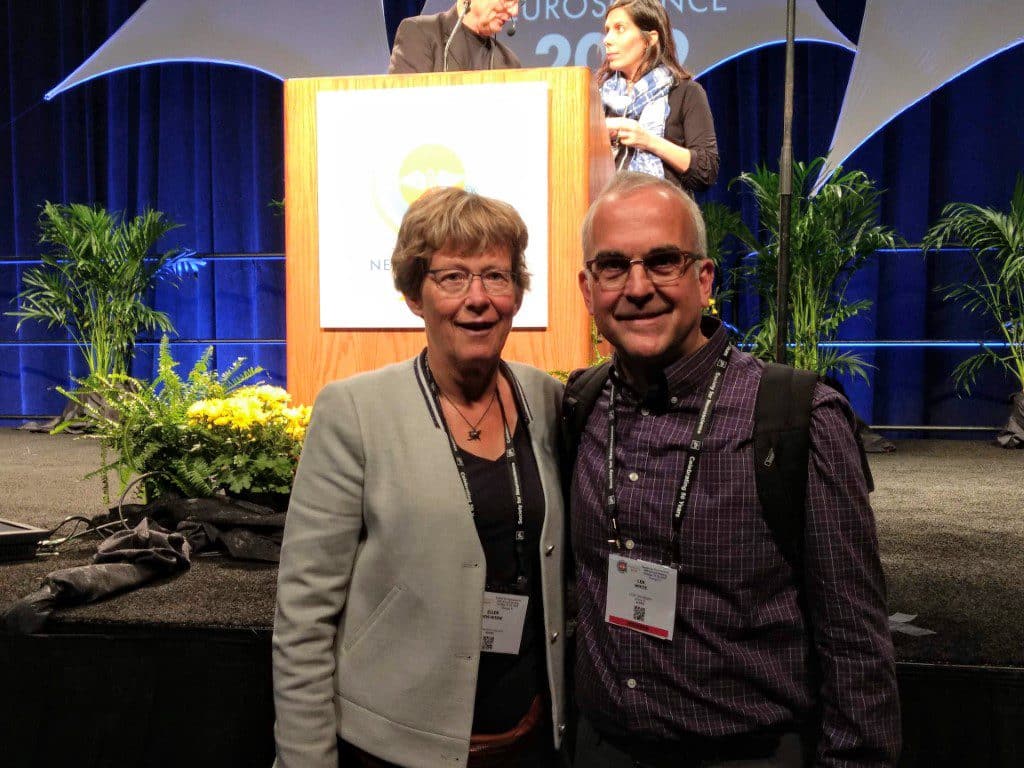Annual meeting of the Society for Neuroscience 2019 in Chicago
Around 30,000 neuroscientists, clinicians, and advocates came together in Chicago October 19–23th 2019 for the annual meeting of the Society for Neuroscience. The meeting is massive! There are poster sessions, symposia and mini symposia, workshops, clinical roundtable meetings, social events and special-interest meetings. It is the largest gathering of neuroscientists in the world. It is likely the largest annual gathering of scientists of any discipline. And Prof. White and Ellen Vos-Wisse were present!
As in 2017 (see: on the annual meeting Society for Neuroscience 2017) I was invited to join the annual meeting of the Society for Neuroscience in 2019.


Len and Ellen near the podium in the massive “Hall B” at McCormick Place (Chicago), just before the plenary lecture on “Neuroethics” by Prof. Nita Farahany (seen above Len in the photo to the right).
Posters
There were 1,000s of posters and this opened up the possibility to talk to the poster presenters in depth about their research.
This time, there were posters presented in a new way with a clear structure that is shown in this really engaging video:
Presenting information on a poster this way makes the information really accessible to the audience that is visiting the poster and wants to discuss the subject.
Poster presenters have been forced to really get into the core of what they want to present when they are using this approach. They are much better in presenting the headlines and not tempted to go too deep into the actual research design, data and conclusions. They do not create a ‘smoke screen’ of very detailed and less important facts. They really open their research up to those that are interested. Thus there is a much better possibility to react on that and have a productive conversation.
Plenary Lectures
There are several type of lectures: Featured lectures and special lectures all lasting about 1:10 hours. They are really very good giving a broad overview of state of the art neuroscience without going into overwhelming details.
If there should be Olympic Games for oral presentations to a huge audience many of these presenters would be in the Gold Medal class. They do what some good poster presenters also did, get into the core of the research they are presenting but they also offer something else; they give a good overview of the current state of affairs in the field they represent.
I am a neuroscientist with a bit of knowledge about a lot of research domains but not much in depth knowledge about one field of neuroscience. When there are a lot of acronyms or abbreviations used in a lecture that makes it very much harder for me to follow because I keep going back in my mind “What does Xo19DA stand for again?” I do not have time to note down acronyms and abbreviations during the lecture because then I can’t follow the train of thought of the presenter. For me it would be better if in the Neuroscience Meeting Planner there would not only be an abstract of the content of the presentation but also a list of the acronyms and abbreviations used in the lecture. I learn that list beforehand if I felt I had to do that or open that list on my telephone during the lecture so that I could always go back to it when I needed the information during the lecture.
The lectures are not supposed to be recorded and slides are not supposed to be photographed, but I saw a lot of people recording lectures and filming slides during the talk. I can understand that because the slides and/or papers concerning the talk are not available for the audience. It is often yet unpublished science that the presenters want to share with the academic world themselves by publishing the results. But it leaves the audience with nothing but the notes you make during the lecture. Maybe it would be a good idea if the presenter made a 1 page A4 handout with the main points that she or he wants his audience to take away from the lecture. It is much easier for the audience to stimulate the memory; maybe the need to record the whole lecture would be less felt by a lot of people.
So there are three points for the organizers of SfN2010:
- Could there be a Summary and a separate list of Acronyms Abbreviations used in the lectures in the Neuroscience Meeting Planner?
- Could there be a handout with 1 page A4 information containing the main points that the lecturer wants his audience to take away from the lecture for the people that attend the lecture?
- Could there be a “visual summary” or “graphical abstract” of each plenary lecture in the style that many scientific journals are now adopting.
Symposia
There are different types of symposia: Symposia (audience size 500-1000; each presentation 35 minutes). Minisymposia (audience 500-1000; 20 minutes each presentation). Nanosymposia (audience 200-600, 15 minutes each presentation).
It seems well organized symposia and mini symposia give a break from the hectic poster sessions and can generally speaking give a good opportunity to come to rest and be immersed in neuroscience at the same time.
My highlights of SfN2019
Myelination and Microglia
The first day of the conference my attention was really caught by the presentation of Ragnhildur T. Karadottir called Neuronal Activity-Dependent Myelination: A Mechanism for Learning and Repair?. This talk gave e very clear overview over the history of Myelin research. The description of the actions and responses of oligodendrocyte progenitor cells (OPC) sparked my interest and made me attend the symposium on Myelin Degeneration and Remyelination in Health and Disease the following day. This symposium was very well organized and the first speaker successfully described the framework of the following talks.
I also attended the Symposium CNS Scarring, Inflammation and Repair. That Symposium took place at the afternoon of the last day of the conference and still managed to attract a good audience. Audience members had made a good choice to come to this symposium. They were rewarded with a well-organized symposium, the first speaker again giving a good framework for the following speakers.
After all this I gained insight in myelination, microglia and their function in the neural system. But it left me also with a lot of scientific questions. What an interesting field of study!
Model systems
On Monday dr. Daniel A. Colón-Ramos gave a lecture The Cell Biology of the Synapse and Behavior. In his research Colón Ramos uses Caenorhabditis elegans. This is a free living transparent nematode in which individual cells are so well described that they can be used in comparative research. Every neuron in this animal’s body has been recognized and catalogued by scientists. dr. Colón-Ramus stressed that the animal model that he uses contributes to the success of the research.
On Tuesday dr. Ulrike Heberlein gave a lecture titled Flies and Alcohol: An Interplay of Nature and Nurture. In her talk dr. Heiberlein also reserved time to talk about the importance of the model system, Drosophila Melanogaster for this field of research on genes, molecular pathways and neural circuits that mediate highly conserved behavioral responses to alcohol. This seems to imply that it could be relevant to the neuroscience of alcoholism in humans.
In the Symposium CNS Scarring, Inflammation and Repair there was a lecture by M. H. Mokalled titled Mechanisms of glial bridging during spinal cord regeneration. In this research he uses Danio rerio (the zebra fish) as an animal model. This is a vertebrate. Humans and zebra fish seem to have more in common than humans and Drosophila and/or Caenorhabditis. But the repair of CNS injury in Danio is not a conserved trait spinal repair in mammals is different. 8 Days after Spinal Cord Injury the zebra fish can swim again. In this model animal microglia can form glial bridges that can restore neural function. Mammals form fibrotic scarring that is not formed in Danio. The process of healing after injury in fish is different from that in mammals.
It made it clear to me that you have to be careful in extrapolating results from research in an animal model to humans.
Wonderful experience
Attending SfN2019 has been a wonderful experience for me. I have given you only the tip of the iceberg of insights and information I gained at the meeting and I really would like to thank Prof. White for giving me the possibility to attend. I am already looking forward to SfN2020 in Washington D.C.